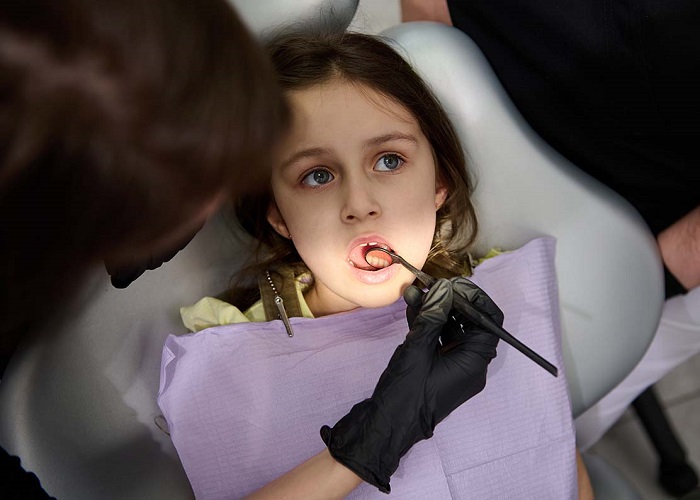Congratulations on becoming a parent! It’s a whirlwind of emotions, sleepless nights, and endless cuddles. But amidst the joy, there can be moments of worry, especially when it comes to your little one’s health. One area that might cause some unexpected concern is their tiny teeth. While baby teeth may seem temporary, they play a crucial role in speech development, chewing, and even jaw growth. So, it’s important to be prepared for and have an emergency dental Las Vegas contact for emergencies that might arise.
This guide aims to equip you with the knowledge and confidence to handle those moments when your child’s pearly whites take a tumble (literally or figuratively).
Common Pediatric Dental Emergencies:
- Knocked-Out Tooth: This is a classic childhood mishap and a major cause for parental panic. Here’s what to do:
- Stay Calm: Your child will be scared, so staying calm will help them feel reassured.
- Find the Tooth: Locate the tooth carefully. If it’s dirty, rinse it gently with water (no soap!).
- Reimplantation (Permanent Teeth Only): Ideally, try to reimplant the tooth back into the socket. Hold it gently in place and have your child bite down on a gauze pad or tissue to stabilize it.
- Storage (Permanent Teeth Only): If reimplantation isn’t possible, store the tooth in milk (whole milk is best) or a commercial tooth preservation solution.
- See the Dentist Immediately: Time is crucial! Regardless of reimplantation, getting to a dentist within 60 minutes significantly increases the chance of saving the tooth.
- Toothache: A toothache can be uncomfortable for your child. Here’s how to manage it:
- Pain Relief: Give age-appropriate pain relievers like acetaminophen or ibuprofen according to the recommended dosage.
- Warm Saltwater Rinse: A warm saltwater rinse can help soothe inflammation. Mix a teaspoon of salt with warm water and have your child gently swish and spit.
- Identify the Cause: Look for signs of swelling, redness, or a broken tooth. This will help determine the severity and inform your next steps.
- See the Dentist: A toothache can signify a deeper problem. Schedule a dental appointment as soon as possible to diagnose and address the cause.
- Chipped or Fractured Tooth: This can happen due to a fall or other accidents. Here’s what to do:
- Control Bleeding: Apply gentle pressure with a gauze pad to control any bleeding.
- Pain Relief: Use age-appropriate pain relievers like mentioned before.
- See the Dentist: A chipped tooth may not be a major concern, but a fractured tooth might require treatment to protect the pulp and prevent further damage. The dentist will assess the severity and recommend the appropriate course of action.
- Oral Abscess: This is a pus-filled infection that can be quite painful. Here’s what to do:
- Pain Relief: Give age-appropriate pain relievers for discomfort.
- Warm Compress: Apply a warm compress to the affected area to reduce swelling.
- See the Dentist Immediately: Abscesses require prompt treatment with antibiotics to prevent the infection from spreading.
4. Swollen Gums: Swollen gums can be caused by various factors like gingivitis (gum inflammation), allergies, or an erupting tooth. Here’s what to do:
- Warm Saltwater Rinse: Encourage gentle swishing with warm saltwater to reduce inflammation.
- See the Dentist: If the swelling persists, is accompanied by pain or fever, or seems unusual, consult a dentist to determine the cause and treatment plan.
Remember: This list is not exhaustive. If you notice anything unusual in your child’s mouth that concerns you, don’t hesitate to reach out to a pediatric emergency dentist Las Vegas.
Prevention is Key:
While being prepared for emergencies is important, preventing them is even better! Here are some tips for good oral health habits in children:
- Start Early: Even before the first tooth erupts, wipe your baby’s gums with a clean, damp washcloth after feedings. This removes bacteria and gets them accustomed to oral care routines.
- Teething Relief: Use teething rings or chilled washcloths to soothe discomfort during teething.
- Brushing: Once the first tooth appears, begin brushing twice a day with a soft-bristled infant toothbrush and a smear of fluoride-free toothpaste. As your child gets older, gradually increase the amount of toothpaste to a pea-sized amount and supervise brushing until they have the dexterity to manage on their own.
Conclusion
Childhood is a time of exploration and adventure, but it can also come with unexpected bumps and bruises – sometimes even to tiny teeth. By familiarizing yourself with common pediatric dental emergencies and knowing how to react, you can stay calm and take the necessary steps to ensure your child’s oral health. Remember, prevention is always the best medicine. Developing good oral hygiene habits early on can significantly reduce the risk of future problems.
Above all, don’t hesitate, seek professional help when deemed necessary. Pediatric dentists are specially trained to handle children’s unique needs and anxieties. A regular dental checkup allows them to monitor your child’s oral development and identify any potential issues before they escalate into emergencies.
With a little knowledge, preparation, and a proactive approach to dental care, you can help your child navigate the world of chompers with confidence and a healthy smile!





